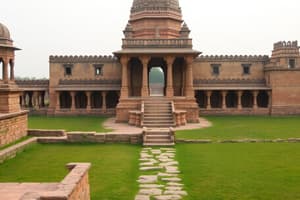Podcast
Questions and Answers
What is the time period of the Medieval Period in India?
What is the time period of the Medieval Period in India?
- 5th to 15th century
- 6th century to the 18th century (correct)
- 8th to 19th century
- 7th to 17th century
What is the Gupta Empire known for?
What is the Gupta Empire known for?
- Contributions to art, architecture, and literature
- Advances in science, mathematics, astronomy, religion, and philosophy (correct)
- Patronage of arts and culture
- Ruling parts of South India
Who ruled northern India in the 7th century?
Who ruled northern India in the 7th century?
- Harsha Vardhana (correct)
- Qutb-ud-din Aibak
- Rashtrakutas
- Chalukyas
What is a significant cultural development during the Early Medieval Period?
What is a significant cultural development during the Early Medieval Period?
Which dynasty dominated the Deccan region?
Which dynasty dominated the Deccan region?
Who founded the Delhi Sultanate?
Who founded the Delhi Sultanate?
Who is credited with the construction of the Qutub Minar?
Who is credited with the construction of the Qutub Minar?
What is Alauddin Khilji known for?
What is Alauddin Khilji known for?
Who is the founder of the Mughal Empire?
Who is the founder of the Mughal Empire?
What is Shah Jahan known for?
What is Shah Jahan known for?
What is a significant cultural contribution of the Mughal Empire?
What is a significant cultural contribution of the Mughal Empire?
What is the characteristic of the Medieval Period of India?
What is the characteristic of the Medieval Period of India?
Flashcards are hidden until you start studying
Study Notes
The Medieval Period of India
Introduction
- The Medieval Period in India spans roughly from the 6th century to the 18th century, marking a significant era of transformation in Indian history.
- This period witnessed the rise and fall of several dynasties, the establishment of powerful empires, the influx of Islamic culture, and the emergence of unique architectural and cultural contributions.
Early Medieval India (6th to 12th century)
Important Dynasties
- Gupta Empire (4th to 6th century): Known as the Golden Age of India, marked by advances in science, mathematics, astronomy, religion, and philosophy, and declined due to Huna invasions.
- Harsha's Empire (7th century): Harsha Vardhana ruled northern India, patronized arts and culture, and after his death, the empire fragmented.
- Chalukyas and Pallavas (6th to 8th centuries): Ruled parts of South India, known for temple architecture, especially the rock-cut temples.
- Rashtrakutas (8th to 10th centuries): Dominated the Deccan region, contributed to art, architecture, and literature.
Cultural Developments
- Classical Sanskrit literature flourished.
- Regional languages and scripts developed.
- Architectural innovations, including the construction of grand temples and intricate sculptures.
Later Medieval India (12th to 18th century)
Delhi Sultanate (1206-1526)
- Mamluk Dynasty (1206-1290): Founded by Qutb-ud-din Aibak, constructed Qutub Minar.
- Khilji Dynasty (1290-1320): Alauddin Khilji expanded the empire significantly, introduced market reforms and administrative measures.
- Tughlaq Dynasty (1320-1414): Muhammad bin Tughlaq's ambitious projects and their failures, Firoz Shah Tughlaq's public works and infrastructure development.
- Sayyid and Lodi Dynasties (1414-1526): Decline in central power, increasing regional autonomy.
Mughal Empire (1526-1857)
- Babur (1526-1530): Founder of the Mughal Empire after the Battle of Panipat.
- Akbar (1556-1605): Expanded the empire through military conquests and diplomacy, promoted religious tolerance and cultural integration, developed an efficient administrative system.
- Jahangir (1605-1627): Patron of arts, continued policies of Akbar.
- Shah Jahan (1628-1658): Known for architectural marvels, including the Taj Mahal.
- Aurangzeb (1658-1707): Expanded the empire to its greatest extent, imposed strict Islamic laws, leading to internal strife.
Cultural Contributions
- Flourishing of Indo-Islamic architecture, including forts, palaces, and mosques.
- Development of miniature painting and Persian literature.
- Introduction of new crops and culinary practices.
Conclusion
- The Medieval Period of India was a time of dynamic change, marked by the rise and fall of powerful dynasties, significant cultural and architectural advancements, and the blending of various traditions and practices.
- This era laid the groundwork for modern Indian society and contributed richly to its cultural heritage.
Studying That Suits You
Use AI to generate personalized quizzes and flashcards to suit your learning preferences.




